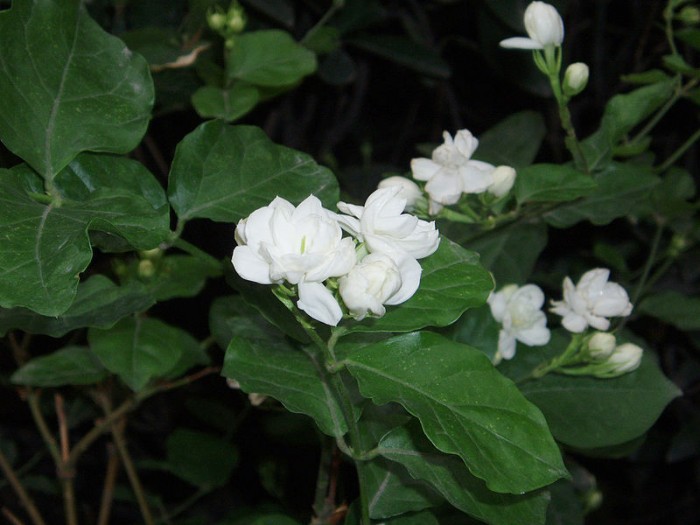Benutzer-Werkzeuge
Dies ist eine alte Version des Dokuments!
Jasminum sambac (L.) Aiton - Oleaceae - Arabian jasmine, Arabischer Jasmin
Twining shrub, up to 3m tall, native to India; leaves opposite, simple, obovate, pubescent; flowers very fragrant, white. „Widely cultivated for its very fragrant flowers that are used in tea flavoring and in perfumes. The flowers and leaves are also medicinal.“
http://www.efloras.org/florataxon.aspx?flora_id=2&taxon_id=200017788
„Despite the English common name of „Arabian jasmine“, Jasminum sambac is not originally native to Arabia. The habits of Jasminum sambac support a native habitat of humid tropical climates and not the arid climates of the Middle East.“ http://en.wikipedia.org/wiki/Jasminum_sambac
„The composition of the volatile fraction of Egyptian Jasminum sambac (L.) Ait. (Family: Oleaceae) flowers picked in July (the climax of the flowering season), was studied using GC/MS. The flowers’ concrete headspace (HS) volatiles had been analyzed by SPME (solid phase microextraction) and compared with those from the flowers’ absolute. The main volatile constituents of the concrete HS and the absolute, respectively, were: benzyl acetate (23.7 and 14.2%), indole (13.1 and 13.4%), (E,E)-α-farnesene (15.9 and 13.1%), (Z)-3-hexenyl benzoate (4.9 and 9.4%), benzyl alcohol (7.7 and 8.4%), linalool (10.6 and 6.3%), and methyl anthranilate (5.0 and 4.7%). The major volatile constituents of Egyptian J. sambac absolute are almost qualitatively similar but quantitatively different from those grown in other geographical regions. The proportion of some major volatile constituents at this investigation are also different from those reported in a previous investigation for Egyptian J. sambac. The study also revealed that, headspace-solid phase microextraction (HS-SPME), equipped with a polydimethylsiloxane (PDMS) fiber, can give an indication about the composition of some of the major volatile constituents of J. sambac, e.g., indole, methyl anthranilate and E-E-α-farnesene, directly from the concrete HS.“
[Isolation and characterization of the volatile aroma compounds from the concrete headspace and the absolute of Jasminum sambac (L.) Ait.(Oleaceae) flowers grown in Egypt., Edris, A.E., Chizzola, R., Franz, C., European Food Research and Technology, Vol.226(3), 2008, 621-626]
HS-SPME analysis of floral volatiles emitted by living J.sambac flowers showed α-farnesene (80%) as main constituent, accompanied by benzyl acetate (2.4%), (Z)-3-hexenyl benzoate (2.2%) and (Z)-3-hexenyl acetate (0.9%), δ-cadinene (2.0%), and methyl anthranilate (1.9%). Indole (0.4%), (Z)-jasmone (0.1%) and linalool (0.9%) as well as (E)- and (Z)-nerolidol (0.3%) contribute to the odor of the flowers.
[Analysis of floral volatiles by using headspace-solid phase microextraction: a review., Rout, P.K., Rao, Y.R., Naik, S.N., Asian J. Chem., Vol.24, 2012, 945-956]
„The odorants in Chinese jasmine green tea scented with jasmine flowers (Jasminum sambac) were separated from the infusion by adsorption to Porapak Q resin. Among the 66 compounds identified by GC and GC/MS, linalool (floral), methyl anthranilate (grape-like), 4-hexanolide (sweet), 4-nonanolide (sweet), (E)-2-hexenyl hexanoate (green), and 4-hydroxy-2,5-dimethyl-3(2H)-furanone (sweet) were extracted as potent odorants by an aroma extract dilution analysis and sensory analysis. The enantiomeric ratios of linalool in jasmine tea and Jasminum sambac were determined by a chiral analysis for the first time in this study: 81.6% ee and 100% ee for the (R)-(-)-configuration, respectively. The jasmine tea flavor could be closely duplicated by a model mixture containing these six compounds on the basis of a sensory analysis. The omission of methyl anthranilate and the replacement of (R)-(-)-linalool by (S)-(+)-linalool led to great changes in the odor of the model. These two compounds were determined to be the key odorants of the jasmine tea flavor.“
[Identification of potent odorants in Chinese jasmine green tea scented with flowers of Jasminum sambac., Ito, Y., Sugimoto, A., Kakuda, T., Kubota, K., Journal of agricultural and food chemistry, Vol.50(17), 2002, 4878-4884]

Jasminum sambac (L.) Sol., Botanical Register, vol. 1: t. 1 (1815) [S. Edwards]
http://www.plantillustrations.org/species.php?id_species=566638

Arabian jasmin 'Arabian Nights'
CC BY-SA 3.0, Author: Fanghong Wikimedia Commons
